Spirit of St. Louis Video - Picture
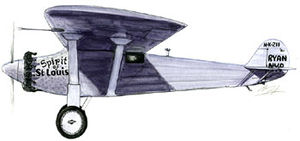
|
|
Spirit of St. Louis
Spirit of St. Louis Ryan NYP

Picture - Illustration of the Spirit of St. Louis
Role: Long-range aircraft [for record attempt]
Manufacturer: Ryan Airlines
Designed by: Donald A. Hall
First flight: April 28, 1927
Retired: April 30, 1928
Primary user: Charles Lindbergh
Produced: 1927
Number built: 1
Unit cost: $10,000
Developed from: Ryan M-2
Career:
Registration: N-X-211
First flight: April 28, 1927
Flights: 174
Total hours: 489 hours, 28 minutes
Preserved at: National Air and Space Museum
The Spirit of St. Louis (Registration: N-X-211) is the custom-built single engine, single seat monoplane that was flown solo by Charles Lindbergh on May 20-21, 1927, on the first non-stop flight from New York to Paris for which Lindbergh won the $25,000 Orteig Prize.
Lindbergh took off in the Spirit from Roosevelt Airfield, Garden City (Long Island), New York and landed 33 hours, 30 minutes later at Le Bourget Aerodrome in Paris, France.
Design and development
Officially known as the Ryan NYP (for New York to Paris), the single-engine monoplane was designed by Donald A. Hall of the aircraft manufacturer Ryan Airlines located in San Diego, California, and was named The Spirit of St. Louis in honor of Lindbergh's supporters in his then hometown of St. Louis, Missouri. To save design time the NYP was loosely based on the company's 1926 Ryan M-2 mail-plane with the main difference being the 4,000 mile range of the NYP, and as a non-standard design the Government assigned it the registration number N-X-211 (for "experimental"). Hall documented his design in "Engineering Data on the Spirit of St. Louis" which he prepared for the US NACA and is included as an appendix to Lindbergh's 1953 Pulitzer Prize winning book, The Spirit of St. Louis.
In 1927, the company was owned by Benjamin Franklin Mahoney who had co-founded it as an airline in 1925 with T. Claude Ryan. The latter remained with the company after Mahoney bought out his interest in 1926, but there is some dispute as to how involved Ryan may have been in its management after selling his share. It is known, however, that Hawley Bowlus was the factory manager who oversaw construction of the Ryan NYP, and that B.F. Mahoney was the sole owner at the time of Donald A. Hall's hiring. Although the "Spirit" was designed and built in San Diego for a flight from New York to Paris, it was named after the city of St. Louis, Missouri because both Lindbergh and his financial backers lived in that city. The flight was inspired by the $25,000 Orteig Prize for the first non-stop flight between New York and Paris which Lindbergh would win in the monoplane. (The three earlier failed attempts made prior to Lindbergh's flight, in which a total of six aircrew were killed, all involved biplanes.) Hall and Ryan Airlines' staff worked closely with Lindbergh to design and build the Spirit in just 60 days. Although what was actually paid to Ryan Aeronautical for the project isn't clear, Mahoney offered to do it "at cost."
Design
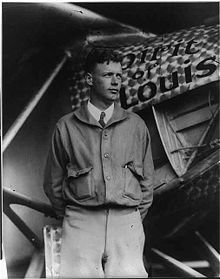
Picture - Lindbergh and the Spirit of St. Louis at Roosevelt Field
Lindbergh believed that multiple engines resulted in a greater chance of failure while a single-engine design would give him greater range. To increase fuel efficiency, the Spirit of St. Louis was also one of the most advanced and aerodynamically streamlined designs of its era.
Lindbergh believed that a flight made in a single-seat monoplane designed around the dependable Wright J-5C "Whirlwind" radial engine provided the best chance of success. The Ryan NYP had a fuel capacity of 450 U.S. gallons (1,700 l; 370 imp gal) or 2,385 pounds (1,082 kg) which was necessary in order to have the range to make the anticipated flight non-stop. The large main fuel tank was placed in the forward section of the fuselage, in front of the pilot, which improved the center of gravity. While locating fuel tanks at the front reduced the risk of the pilot's being crushed to death in the event of a crash, this design decision also meant that there could be no front windshield, and that forward visibility would be limited to side windows only. A periscope was installed to provide a forward view, as a precaution against hitting ship masts, trees, or structures while flying at low altitude; however, it is unclear whether the periscope was used during the flight. Lindbergh also used special navigation instruments such as the Earth Inductor Compass as its main instrument, allowing Lindbergh to navigate while taking account of the magnetic declination of the earth.
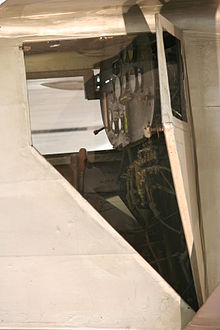
Picture - Spirit of St. Louis cockpit, Washington, D.C.
Lindbergh sat in a cramped cockpit which was 94 cm wide, 81 cm long and 130 cm high (36 in x— 32 in x— 51 in). The cockpit was so small, Lindbergh could not stretch his legs. The Spirit of St. Louis was powered by a 223-horsepower (166 kW), air-cooled, 9-cylinder Wright J-5C "Whirlwind" radial engine. The engine was rated for a maximum operating time of 9,000 hours (more than one year if operated continuously), and had a special mechanism that could keep it clean for the entire New York-to-Paris flight. It was also, for its day, very fuel efficient enabling longer flights carrying less fuel weight for given distances. Another key feature of Lindbergh's radial engine was that it was rated to self-lubricate the engine's valves for 40 hours continuously. Lubricating, or "greasing," the moving external engine parts was a necessity most aeronautical engines of the day required to be done manually by the pilot or ground crew prior to every flight and would have been otherwise somehow required during such a long flight.
The engine was built at Wright Aeronautical in Paterson, New Jersey by a 24-year old engine builder, Tom Rutledge, who was disappointed that he was assigned to the unknown aviator Charles Lindbergh. Four days after the flight he received a letter of congratulations from the Wright management. His estate owns pictures of historical interest.
The race to win the Prize required time saving design compromises. The original wingspan of the Ryan M2 was increased by 10 ft and redesigned to create a surface area large enough to lift 450 U.S. gallons of fuel (carried in five fuel tanks: left wing, right wing, mid wing, nose and in available payload space) along with the lone pilot and minimum necessary gear.
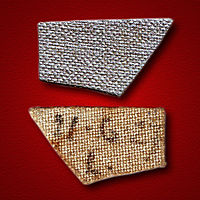
Picture - Sample of the treated fabric from the Spirit of St. Louis
However, Donald A. Hall decided that the empennage (tail assembly) and wing control surfaces would not be altered from his original Ryan M-2 design, thus minimizing redesign time that was not available without delaying the flight. The result was less aerodynamic stability; nevertheless the experienced Lindbergh approved the unaltered design. This setup resulted in a negatively stable design that tended to randomly introduce unanticipated pitch, yaw, and bank (roll) elements into its overall flight characteristics. There is dispute regarding whether Hall and Lindbergh also preferred this design because they anticipated that the continuous corrections to the random movements of the aircraft would help to keep Lindbergh awake during the estimated 40-hour flight. Whether or not the unstable design was deliberately retained to help fight fatigue, Lindbergh did later write how these random unanticipated movements helped keep him awake at various times during the flight. The stiff wicker seat in the cockpit was also purposely uncomfortable, though custom fitted to Lindbergh's tall and lanky frame.
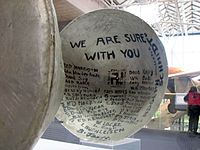
Picture - Inside of the original propeller spinner of the Spirit of St. Louis
Lindbergh also insisted that unnecessary weight be eliminated, even going so far as to cut the top and bottom off of his flight map. He carried no radio in order to save weight and because the radios of the period would have been unreliable and difficult to use while flying solo. Also, although he was an airmail pilot, he refused to carry souvenir letters on the transatlantic journey, insisting that every spare ounce be devoted to fuel. The fuselage was made of treated fabric over a metal-tube frame, while the wings were made of fabric over a wood frame.
A small, left-facing Indian-style swastika was painted on the inside of the original propeller spinner of the Spirit of St. Louis along with the names of all the Ryan Aircraft Co. employees who designed and built it. It was meant as a message of good luck prior to Lindbergh's solo Atlantic crossing as the symbol was often used as a popular good luck charm with early aviators and others. The inside of the original propeller spinner can be viewed at the National Air and Space Museum. This propeller spinner was found to be cracked when Lindbergh arrived at New York prior to his transatlantic flight. The propeller spinner that is on the Spirit of St. Louis now was hastily made in New York to replace the cracked original and was on the plane during the transatlantic flight.
Later history and conservation
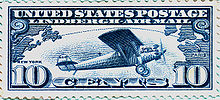
Picture - 10c US Air Mail stamp (C-10) honoring Capt. Charles Lindbergh and the Spirit of St Louis (issued June 11, 1927)
Lindbergh's prize winning New York to Paris flight made him an instant celebrity and media star. In successfully winning the Orteig Prize, his solitary flight seemed to stir the public's imagination. He wrote: "I was astonished at the effect my successful landing in France had on the nations of the world. It was like a match lighting a bonfire." Lindbergh subsequently flew the Spirit of St. Louis to Belgium and England before President Calvin Coolidge sent the United States Navy cruiser USS Memphis (CL-13) to bring them back to the United States. Arriving on June 11, Capt. Lindbergh and the Spirit were escorted up the Potomac River to Washington, D.C. by a fleet of warships, multiple flights of military pursuit planes, bombers, and the rigid airship USS Los Angeles (ZR-3) where President Coolidge then presented the 25-year old U.S. Army Reserve aviator with the Distinguished Flying Cross. On the same day, the U.S Post Office issued a commemorative 10 Cent "Lindbergh Air Mail" stamp depicting the Spirit over a map of the route of its flight from New York to Paris, and which was also the first stamp ever issued by the USPOD that bore the name of a living person. Over the next 10 months, Lindbergh flew his now-famous flying "partner" on a series of promotional and goodwill tours across the United States and Latin America.

Picture - The Spirit at the National Air and Space Museum
Just one year and two days after making their first flight at Dutch Flats in San Diego, CA, on April 28, 1927, Lindbergh and the Spirit flew together for the final time while making a hop from St. Louis to Bolling Field, in Washington, D.C., on April 30, 1928. There he presented his iconic monoplane to the Smithsonian Institution where for more than eight decades it has been on public display, today hanging in the atrium the National Air and Space Museum alongside the Bell X-1 and SpaceShipOne. At the time of its retirement, the Spirit had made just 174 flights for a total of 489:28 flying time.
While in other respects the Spirit of St. Louis appears today much as it appeared on its accession into the Smithsonian collection in 1928, the gold color of the aircraft's aluminum nose panels is an artifact of well-intended early conservation efforts. Not long after the museum took possession of the Spirit, conservators applied a clear layer of varnish or shellac to the forward panels in an attempt to preserve the flags and other artwork painted on the engine cowling. This protective coating has yellowed with age, resulting in the golden hue seen today. Smithsonian officials have indicated that the varnish will be removed, and the nose panels restored to their original silver appearance, the next time the plane is taken down for conservation.
Further developed types
NYP-2, an exact duplicate of the Spirit of St. Louis was built 45 days after the transatlantic flight, for the Japanese newspaper Mainichi. The NYP-2 carrying serial number 29 was registered as J-BACC and achieved a number of record-breaking flights early in 1928 before a crash ended its career.
Although Ryan capitalized on the notoriety of the NYP special, further developments were only superficially comparable to the Spirit of St. Louis. An offshoot of the Ryan B-1 Brougham emerged as a five-seater with the same J-5 engine but modified with a conventional cockpit layout and a shorter wingspan. Under the newly restructured B.F. Mahoney Company, further development continued with the six-place Model B-7 utilizing a 420 hp engine and the Model C-1 with the basic 220 hp engine. In 1928, Mahoney built a B-1X as a gift for Charles Lindbergh.
Reproductions
The 1938 Paramount film Men with Wings starring Ray Milland featured a reproduction of the Spirit of St. Louis fashioned from a Ryan B-1 "Brougham" similar to one presented to Lindbergh by the manufacturer, the Mahoney Aircraft Corporation, shortly after the Spirit was retired in April 1928. All three reproductions survived with B-153 on display at the Missouri History Museum, in St. Louis, B-156 is part of the collection at the Henry Ford Museum in Dearborn, Michigan, and B-159 belongs to the Cradle of Aviation Museum located in Garden City, Long Island, New York, not far from the site of Roosevelt Field from which the original departed in 1927. Reputed to have been flown by Lindbergh during the film's production, the connection to Lindbergh is now considered a myth. A 90% static reproduction was also built in 1956 for the film The Spirit of St Louis by the Warner Brothers Movie studio which is now on display at the Minneapolis-Saint Paul International Airport.
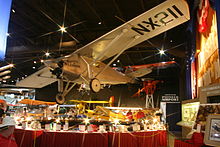
Picture - Spirit of St. Louis replica at EAA AirVenture Museum
Through the efforts of both staff and volunteers, the Experimental Aircraft Association in Oshkosh, Wisconsin produced two Spirit reproductions powered by Continental R-670-4 radial engines, the first in 1977 (the first of which was to be based on a conversion from a B-1 Brougham; the airplane proved to be too badly deteriorated to be used in that manner) to commemorate the 50th anniversary of Lindbergh’s flight across the Atlantic Ocean and subsequent tour of the United States. This example is now on display in the main museum gallery. A second reproduction, started from scratch in 1977 and first flown in November 1990, continues to fly at air shows and commemorative events. Both of the EAA reproductions were registered under the original's N-X-211.
On the 40th anniversary of Lindbergh's flight a new reproduction was built by Frank Tallman. It first flew on April 24, 1967 and was named Spirit 2. Spirit 2 appeared at the 1967 Paris Air Show and made several flights over Paris. In 1972, Spirit 2 was bought for $50,000 by the San Diego Air & Space Museum (formerly San Diego Aerospace Museum) and placed on public display until it was destroyed by arson in 1978. The museum built a replacement named Spirit 3 which first flew on April 28, 1979; it made seven flights before being placed on display. In August 2003, the Spirit 3 was removed from display and was flown as a 75th Anniversary tribute to Lindbergh. The aircraft is now on display in the museum's rotunda.
The San Diego Air & Space Museum also built a non-flying example which was fitted with an original Wright J-5 engine which was placed on display at the San Diego International Airport in 1999.
Another airworthy reproduction was built by David Cannavo and first flown in 1979, powered by a Lycoming R-680 engine. In 1995 it was bought by Kermit Weeks for his Fantasy of Flight Museum in Polk City, Florida.
Another Spirit of St. Louis static reproduction was built in 2002 and is on display at the Lambert-Saint Louis International Airport. The Octave Chanute Aerospace Museum at Rantoul, Illinois has a static reproduction built by museum volunteers. Two reproductions are also found in Germany, one at the Frankfurt International Airport with the second in a private collection. Another European-based reproduction of the Spirit (Registration ES-XCL), which had been built and certified in Estonia in 1997, was written off when structural failure shortly after taking off at an air show in Coventry, England on May 31, 2003, resulted in a fatal crash killing its owner-pilot, veteran (22,000+ hours) Swedish Saab 340 captain Pierre Hollx¤nder.
A still-unfinished Spirit reproduction, intended to eventually be flyable that is owned by Old Rhinebeck Aerodrome and mostly built by former ORA pilot Ken Cassens, still needs its wing covered with doped fabric and is said to have more original, and still functional 1920s-era flight instruments, that match the ones in the original at the NASM, than any other reproduction of the Spirit yet built.
Specifications (Ryan NYP)
Data from
General characteristics
Crew: One
Length: 27 ft 7 in (8.4 m)
Wingspan: 46 ft (14 m)
Height: 9 ft 10 in (3 m)
Wing area: 320 ft˛ (29.7 m˛)
Airfoil: Clark Y
Empty weight: 2,150 lb (975 kg)
Loaded weight: 2,888 lb (1,310 kg)
Useful load: 450 gal (1,703 l)
Max takeoff weight: 5,135 lb (2,330 kg)
Powerplant: 1x— Wright Whirlwind J-5C Single blade Standard Steel Propeller, 223 hp (166 kW)
Performance
Maximum speed: 133 mph (220 km/h)
Cruise speed: 100- 110 mph (160-175 km/h)
Range: 4,100 mi (6,600 km)
Service ceiling: 16,400 ft (5,000 m)
Rate of climb: Considered ()
Wing loading: 16 lb/ft˛ (78 kg/m˛)
Power/mass: 23 lb/hp (10.4 kg/hp)
Gallery
The Spirit of St. Louis on display in the National Air and Space Museum
Left side of Spirit of St. Louis
Nose of the Spirit of St. Louis, with the Wright Whirlwind Radial engine visible
Spirit of St. Louis
Spirit of St. Louis
Under the tail of the Spirit of St. Louis
Spirit of St. Louis spinner
Spirit of St. Louis model
Charles Lindbergh (Popular culture)
Related development
Ryan M-2
Comparable aircraft
Plus Ultra (flying boat)
The nose of the Spirit of St. Louis is a golden color because of a well-intentioned but mistaken attempt by us to preserve the markings on the cowling. We don’t know exactly when, but soon after the Smithsonian acquired the Spirit in May 1928, we sought to preserve the markings by applying a clear coat of varnish or shellac. Unfortunately, over the years, this coating has yellowed with age. While it has taken on a beautiful golden hue, the color is wrong. The aluminum cowling should be in its natural silver color. In the future, when we next conserve the aircraft, we will carefully remove the coating. This can be done by a painting conservator. Until then, the Spirit will keep its golden nose.
The nose of the Spirit of St. Louis is a golden color because of a well-intentioned but mistaken attempt by us to preserve the markings on the cowling. We don’t know exactly when, but soon after the Smithsonian acquired the Spirit in May 1928, we sought to preserve the markings by applying a clear coat of varnish or shellac. Unfortunately, over the years, this coating has yellowed with age. While it has taken on a beautiful golden hue, the color is wrong. The aluminum cowling should be in its natural silver color. In the future, when we next conserve the aircraft, we will carefully remove the coating. This can be done by a painting conservator. Until then, the Spirit will keep its golden nose.
Citations
Bibliography
Bowers, Peter M. "The Many Splendid Spirits of St. Louis." Air Progress, Volume 20, No. 6, June 1967.
Cassagneres, Ev. The Untold Story of the Spirit of St. Louis: From the Drawing Board to the Smithsonian. New Brighton, Minnesota: Flying Book International, 2002. ISBN 0-911139-32-X.
Hall, Donald A. Technical Preparation of the Airplane "Spirit of St. Louis" N.A.C.A. Technical Note #257 Washington: National Advisory Committee for Aeronautics, July 1927. Retrieved: May 18, 2007.
Hall, Nova S. Spirit and Creator: The Mysterious Man Behind Lindbergh's Flight to Paris. Sheffield, Maryland: ATN Publishing, 2002. ISBN 0-97029644-4.
Hardwick, Jack and Ed Schnepf. "A Viewer's Guide to Aviation Movies." The Making of the Great Aviation Films. General Aviation Series, Volume 2, 1989.
Lindbergh, Charles A. Spirit of St. Louis. New York: Scribners, 1953.
Nevin, David, ed. The Pathfinders (The Epic of Flight, v. 2). Alexandria, Virginia: Time-Life Books, 1980. ISBN 0-8094-3256-0.
Schiff, Barry. "The Spirit Flies On: Remembering the Flight that Changed the Course of History." AOPA Pilot, May 2002. Retrieved: May 18, 2007.
Simpson, Rod. "Preserving the Spirit". Air-Britain Aviation World, Volume 55, no. 4, 2003. ISSN 0950-7434.
Wohl, Robert. The Spectacle of Flight: Aviation and the Western Imagination, 1920-1950. New Haven, Connecticut: Yale University Press, 2005. ISBN 0-30010-692-0.
Spirit of St. Louis Pictures
More aircraft.
Source: WikiPedia